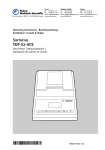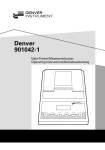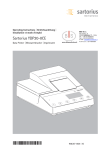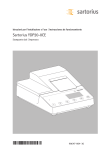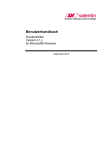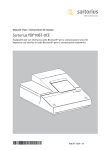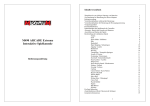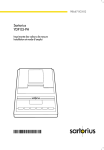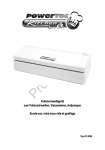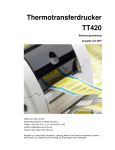Download Sartorius YDP10-0CE - Sartorius Laboratory Products
Transcript
Operating Instructions | Betriebsanleitung | Installation et mode d’emploi Sartorius YDP10-0CE Data Printer | Messwertdrucker | Imprimante des valeurs de mesure 98647-004-31 English – page 3 In cases involving questions of interpretation, the German-language version shall prevail. Deutsch – Seite 17 Im Auslegungsfall ist die deutsche Sprache maßgeblich. Français – page 31 En cas de questions concernant l’interprétation, la version en langue allemande fera autorité. 2 Contents Intended Use 4 Troubleshooting Guide 9 Safety Instructions 4 Maintenance 10 Installation 5 Accessories 14 Operation 8 Specifications 14 Printing a Measured Value from the Connected Weighing Instrument Electromagnetic Compatibility 15 8 Configuration 8 Using the Printer in Legal Metrology 15 Test Certificate 16 3 Intended Use Safety Instructions Model YDP 10-0CE is a data printer designed to receive weighing data from a connected weighing instrument and print it on plain paper (roll width: 57.5 mm). Text and data are printed with up to 24 characters per line. The data printer complies with the EC Directives and Standards for electrical equipment and electromagnetic compatibility. The data printer meets the quality standards for research in the chemical and pharmaceutical industries, in compliance with the requirements of GLP (Good Laboratory Practice) and GMP (Good Manufacturing Practice). The printer can be used for output of weighing data. Data is sent to the output port either automatically or at the press of a key. The printer can be used as auxiliary equipment with a weighing instrument that has been verified for use in legal metrology; see “Using the Printer in Legal Metrology” for more information. Use only rechargeable nickel-metal hydride, size AA (order no. 69Y03136). Avoid draining the batteries completely, as this will reduce their recharging capacity. Used batteries are hazardous waste and must be properly disposed of in accordance with your local hazardous waste disposal regulations. As a rule, the printer is powered over the data cable connected to the weighing instrument. Depending on your weighing instrument model, it may be necessary to use a different external power source. To do this, use only an original Sartorius AC adapter (see “Accessories”). If you have any difficulties, contact our Service Center or your Sartorius dealer. Use only a moist cloth to wipe down the printer to ensure that no liquid enters the printer housing during cleaning. Caution: The serrated edge for tearing off printouts is sharp; direct contact can result in injury. 4 Installation Equipment Supplied The following components are supplied: – Interface cable for connecting the printer to a weighing instrument – Ink ribbon – 4 rechargeable batteries – Paper roll Installing the Rechargeable Batteries § Remove the 4 batteries from the packaging (they are discharged) § Lift the cover of the paper roll compartment § To open the battery compartment, tilt back the cover. LF CN N/ N STAT DA TE § Install the 4 rechargeable batteries in the battery compartment. Make sure that the poles match the + and – signs. § Close the battery compartment § Close the paper roll compartment – You cannot thread the paper roll until the printer has been turned on. 5 Connecting the Data Printer to a Weighing Instrument § Connect the interface cable to the printer and to the weighing instrument. Secure the connection. Turning On the Weighing Instrument and the Printer § Plug in the AC adapter to power the weighing instrument § Turn on the weighing instrument > The printer switches on automatically > The green LED on the left-hand side of the front panel lights up Charging the Batteries during Initial Operation § Charge the batteries by leaving the weighing instrument turned on > The batteries are charged while the weighing instrument is in standby mode > It takes 28 hours to charge the batteries to full capacity $ The LED flashes red to indicate that there is not enough charge in the batteries to power the printer. If the LED does not stop flashing after a maximum of 3 hours charging, the batteries must be replaced (see page12 ). Installing the Ink Ribbon Cassette § For details on installing the ink ribbon cassette, see the section entitled “Maintenance” (page 11). Inserting the Paper Roll 6 § For details on inserting the paper roll, see the section entitled “Maintenance” (page 10). § Plug the original Sartorius AC adapter into an electrical outlet § Insert the right-angle plug into the jack on the righthand side of the printer’s rear panel. The green LED lights up to indicate the presence of voltage. $ For details on installing the batteries, see page 6 $ Follow the steps described in the previous section to connect the printer and the weighing instrument 7 Operation The data printer has 2 function keys for operation: : Line feed; advances the paper by one blank line. : Print measured value or begin automatic printing Printing a Measured Value from the Connected Weighing Instrument $ 123456789012345678901234 001: + 123.4 g § > Advance paper to desired position, if necessary: Press the key (repeatedly if desired), or press and hold for continuous line feed To print data, press the key A sample printout is shown here on the left Configuration Configuring the Operating Menu Note: The connected weighing instrument must be configured for data communication with the printer. Configuring the Weighing Instrument’s Printer Port The following settings are configured in the printer at the factory: 9600 baud, 8 bits, odd parity, one stop bit, hardware handshake (CTS/DTR) When the printer is turned on, these settings are loaded in the printer’s memory (EEPROM) for use during operation. 8 Troubleshooting Guide LED Cause Solution Red Data in printer memory (EEPROM) defective (checksum invalid) § Press the key Red The capacity of the input buffer has been exceeded § Switch the weighing instrument off and then on again § Press the key Red No control signal from printer § § $ $ Flashing red Low battery power § Recharge batteries (see “Maintenance”) > Factory settings are loaded $ It may be necessary to configure menu settings for the printer port and in the statistics application Press the key Check the batteries Recharge batteries if necessary Replace the batteries if necessary Batteries dead Red Transmission error in a data string § Make sure the interface parameter settings in the printer match those in the weighing instrument § Press the key 9 Maintenance Replacing the Paper Roll – – – – – The paper rolls used with your data printer must have the following specifications (see “Accessories”): Standard paper roll Wood-free paper, 60 g Width: 57.5 ± 0.5 mm Diameter: Max. 65 mm Core diameter: Min. 8 mm § Lift the cover of the paper roll compartment § Pull out the roll holders from both sides of the roll core as shown on the left § Remove the old roll core LF CN N/ N STAT DA TE $ Place a new paper roll on a flat surface $ The open end must be on the bottom of the roll and facing the front of the printer § Hold the paper roll above the paper roll compartment between thumb and index finger of one hand § Thread the paper through the slot underneath the ink ribbon with your other hand § To transport the paper through the ink ribbon cassette, press the key repeatedly, or hold it down > The paper will be threaded into, then out of the ink ribbon cassette 10 § To align the paper roll, hold it so that you can push both roll holders into the core § Release the roll holders on both sides § Close the paper roll compartment Replacing the Ink Ribbon Cassette Your data printer requires a black ink ribbon cassette, type ERC-22 (see “Accessories”). § Lift the cover of the paper roll compartment § To remove the paper from the ink ribbon cassette, turn the paper roll opposite to the paper feed direction Press down on the right-hand side of the cassette > The left-hand side of the cassette rises § Remove the cassette § Insert a new ink ribbon cassette from the top > The cassette locks into place $ Turn the small tension wheel located on the left in the direction of the arrow until the ribbon is stretched taut in front of the paper § To thread the paper, see “Replacing the Paper Roll” § Close the paper roll compartment 11 $ > > $ Charging the Batteries If the LED is red (not flashing), the batteries are completely drained. The LED flashes red to indicate that the batteries are charging; do not switch off the weighing instrument. The batteries are charged while the weighing instrument is in standby mode It takes 28 hours to charge the batteries to full capacity If the LED does not stop flashing red within a maximum of 3 hours, replace the batteries Replacing the Batteries ! Avoid draining the batteries completely, as this will reduce their recharging capacity. ! Use only size AA rechargeable nickel-metal hydride batteries (see “Accessories”; order no. 69Y03136). § Lift the cover of the paper roll compartment § To open the battery compartment, tilt back the cover ! Remove the 4 batteries Do not dispose of batteries in normal household waste. Rechargeable batteries contain toxic materials and must be disposed of in accordance with local waste disposal regulations. $ If you have any questions, please contact your local Sartorius Service Center § Place the 4 new batteries in the battery compartment. Make sure that the poles match the + and – signs § Press down on the cover to close the battery compartment § Close the paper roll compartment 12 Cleaning the Data Printer ! When cleaning the data printer, make sure that no liquid enters the housing ! Do not use any aggressive cleaning agents (solvents or similar agents). § Disconnect the power supply by unplugging the interface cable (connecting the weighing instrument) from the rear panel of the printer. $ If you are using an external power supply, unplug the AC adapter from the electrical outlet (mains supply) § Use only a cloth moistened with a mild detergent (soap) to wipe down the printer housing § After cleaning, wipe down the printer with a soft, dry cloth 13 Accessories Product Spare paper rolls (box of 5) Ink ribbon cassette AC adapter with specifications rated for: Europe UK USA Australia South Africa Set of 4 rechargeable batteries (nickel-metal hydride, size AA) Data cable for connecting the printer to a weighing instrument or other device of an older design series (MP technology), for use in residential areas (EN55022, Class B) Order No. 6906937 6906918 6971412 6971414 6971413 6971411 6971410 69Y03136 VF1503 (Fast Factory) Specifications Dimension Length Width Height Weight (without batteries or paper roll) Operating temperature Allowable storage temperature 14 Value 230 mm 158 mm 80 mm Approximately 800 g 0°C to +40°C (32°F to 104°F) -40°C to +70°C (-40°F to +158°F) Electromagnetic Compatibility C Marking Using the Printer in Legal Metrology The printer complies with the following EC Directives and European Standards: 2004/108/EC “Electromagnetic Compatibility (EMC)” Applicable European Standards: Limitation of emissions: In accordance with product standard EN 61326-1 Class B (residential area) Defined immunity to interference: in accordance with product standard EN 61326-1 (industrial environment) The German National Institute of Physics and Metrology (PTB) has issued an independent test certificate for the YDP10-0CE (see certificate for number). With this certificate, the printer is permitted for use in legal metrology in the EU and the EEA. This applies only when the printer is connected to a weighing instrument that has an EC type approval certificate, or a national equivalent, verifying that the weighing instrument is verifiable for legal metrology. Note: The operator shall be responsible for any modifications to Sartorius equipment and for any connections of cables or equipment not supplied by Sartorius and must check and, if necessary, correct these modifications and connections. On request, Sartorius will provide information on the minimum operating specifications (in accordance with the standards listed above for defined immunity to interference). Council Directive 2006/95/EC: “Electrical equipment designed for use within certain voltage limits” Applicable European Standards: EN 61010-1 Safety requirements for electrical equipment for measurement, control and laboratory use Part 1: General requirements If you use electrical equipment in installations and under ambient conditions subject to stricter safety standards than those described in the manual, you must comply with the provisions as specified in the applicable regulations for installation in your country. If the weighing instrument has one or more display digits marked (e = d), the printer must mark these digits as well; for example, with brackets or inverse printing. This does not apply for weighing instruments of accuracy class I with a verification scale interval e = 1 mg and a scale interval of d < 0.1 mg. For weighing instruments with e = d, marking digits is not permitted. Data output from the weighing instrument must be configured so that the marking of digits is passed to the printer and included on the printout. If the printer is subsequently connected to a verified weighing instrument already in use in legal metrology, notify your local weights and measures inspection office or contact your local Sartorius service center if you wish to have the data printer configured and prepared for verification for use in legal metrology. The above does not concern printers that are immediately used in legal metrology. 15 16 Inhalt Verwendungszweck 17 Fehlermeldungen 23 Sicherheitshinweise 18 Instandhaltung 24 Installation 19 Zubehör 28 Betrieb 22 Technische Daten 28 Messwert der angeschlossenen Waage drucken Elektromagnetische Verträglichkeit 29 22 Einsatz im eichpflichtigen Verkehr 29 Voreinstellungen 22 Prüfschein 30 17 Verwendungszweck Sicherheitshinweise Der Typ YDP 10-0CE ist ein Messwertdrucker, der Wägedaten von einer angeschlossenen Waage übernimmt und auf Normalpapier (Rollenbreite: 57,5 mm) ausdruckt. Text wird mit bis zu 24 Zeichen pro Zeile ausgegeben. Der Drucker entspricht den Richtlinien und Normen für elektrische Betriebsmittel und elektromagnetische Verträglichkeit. Der Drucker erfüllt die Qualitätsstandards aus Chemie und Pharmaziedie im Bereich der Forschung unter dem Begriff GLP (Good Laboratory Practice) und in der Fertigung unter dem Begriff GMP (Good Manufacturing Practice) eingeführt sind. Mit dem Drucker können einzelne Wägedaten ausgegeben werden. Die Datenausgabe kann auf Tastendruck oder automatisch erfolgen. Der Messwertdrucker ist als Zusatzeinrichtung bei einer geeichten Waage einsetzbar, siehe unter »Einsatz im eichpflichtigen Verkehr«. Es darf nur folgender Akkutyp (keine Batterien) verwendet werden: Nickel-Metall-Hybrid, Typ AA Best.-Nr. 69Y03136. Tiefentladung der Akkus vermeiden, da sonst die maximale Ladekapazität sinkt. Verbrauchte Akkus müssen als Sondermüll entsorgt werden. Bei externer Spannungsversorgung nur Original Sartorius Netzgerät für diesen Drucker verwenden (siehe Kapitel Zubehör). Das externe Netzgerät ist nur bei bestimmten Waagenserien erforderlich. Im Problemfall den Service oder den Sartorius Händler ansprechen. Die externe Spannungsversorgung erfolgt über das Datenkabel der angeschlossenen Waage. Beim Reinigen dürfen keine Flüssigkeiten in den Drucker gelangen: nur leicht angefeuchtetes Reinigungstuch verwenden. Vorsicht, die gezahnte Papierabrisskante ist scharf, bei direkter Berührung besteht Verletzungsgefahr! 18 Installation Lieferumfang – – – – Folgende Einzelteile werden mitgeliefert: Datenleitung Drucker – Waage Farbband 4 Akkus Papierrolle Akkus einlegen § 4 Akkus aus der Verpackung entnehmen (Akkus sind entladen) § Papierfach öffnen: Papierfachabdeckung anheben § Akkufach öffnen: Akkufachabdeckung aufklappen. LF CN N/ N STAT DA TE § 4 Akkus in Akkufach einsetzen: Polarität beachten! § Akkufach schließen: Akkufachabdeckung schließen § Papierfach schließen: Papierfachabdeckung nach vorne herunterklappen – Die Papierrolle kann erst eingefädelt werden, wenn der Drucker eingeschaltet ist. 19 Drucker an Waage anschließen § Datenverbindungskabel am Drucker und an der Waage anschließen und sichern Waage und Drucker einschalten § Waage mit Netzspannung versorgen: Netzgerätstecker einstecken § Waage einschalten > Drucker schaltet automatisch ebenfalls ein > Die grüne Kontroll-LED links auf der Frontlolie leuchtet. Akkus aufladen bei Erst-Inbetriebnahme § Akkus aufladen: Waage eingeschaltet lassen > Akkus werden im Standby-Betrieb der Waage geladen > nach 28 Stunden sind die Akkus im Drucker aufgeladen $ Wenn die rote LED blinkt, sind die Akkus nicht geladen. Falls die rote LED blinkt und nach spätestens 3 Stunden nicht erlischt: Akkus wechseln, siehe Seite 26 Farbband einlegen § Farbband einlegen: siehe Kapitel Instandhaltung, Seite 25 Papierrrolle einlegen 20 § Papierrolle einlegen: siehe Kapitel Instandhaltung, Seite 24 § Original Sartorius Netzgerät an Netzsteckdose anschließen § Winkelstecker des Netzgeräts an rechten Ausgang der Druckerrückseite anschließen Die grüne LED leuchtet, Netzspannung vorhanden. $ Akkus einlegen: siehe Seite 20 $ Drucker und Waage anschließen und einschalten: siehe vorherigen Abschnitt 21 Betrieb Für den Betrieb des Druckers stehen 2 Tasten zur Verfügung: : Leerzeile drucken; Papiervorschub um 1 Zeile Messwert ausdrucken oder automatisch ausdrucken Messwert der angeschlossenen Waage ausdrucken $ 123456789012345678901234 001: + 123.4 g > § Ggf. einige Leerzeilen drucken (Papiervorschub): Taste (mehrfach) drücken oder gedrückt halten Nebenstehender Ausdruck erscheint (Beispiel) Messwert ausdrucken: Taste drücken Voreinstellungen Voreinstellungen im Menü Hinweis: Alle Einstellungen der Schnittstellenparameter müssen in der angeschlossenen Waage realisiert werden! »Waage, Drucker-Schnittstelle« vornehmen Der Drucker ist ab Werk fest konfiguriert auf: 9600 Baud , 8 bit, odd parity, ein Stop bit, hardware Handshake (CTS/DTR) Alle Voreinstellungen werden beim Start des Druckers aus dem Druckerspeicher (EEPROM) gelesen und anschließend vom Drucker für den Betrieb übernommen. 22 Fehlermeldungen LED Ursache Abhilfe leuchtet rot Daten im Druckerspeicher (EEPROM) sind fehlerhaft (Prüfsumme stimmt nicht) § -Taste drücken > Werksvoreinstellungen werden geladen $ Ggf. Menü Drucker-Schnittstelle und Menü Statistik-Anwendungen neu konfigurieren leuchtet rot Überschreitung der Eingangskapazität des Eingangspuffers § Waage ausschalten und neu einschalten § -Taste drücken leuchtet rot Steuersignale des Drucker fehlen § § $ $ blinkt rot Akkuladung zu gering § Akku aufladen (siehe Kapitel Instandhaltung) -Taste drücken Akkus überprüfen Akkus ggf. aufladen Akkus ggf. wechseln Akku entladen leuchtet rot Übertragungsfehler in einer Datenkette § Einstellungen der Schnittstellenparameter Waage/Drucker auf Gleichheit prüfen § -Taste drücken 23 Instandhaltung Papierrolle wechseln – – – – – Für den Betrieb wird eine Papierrolle mit folgenden Eigenschaften benötigt (siehe auch Kapitel Zubehör): Standard-Papierrolle Holzfreies 60 g Papier Breite: 57,5 ± 0,5 mm Durchmesser: max. 65 mm Offener Kerndurchmesser: min. 8 mm § Papierfach öffnen: Papierfachabdeckung anheben § Rollenhalterungen an beiden Seiten des Rollenkerns nach außen ziehen § Alten Rollenkern entnehmen LF CN N/ N STAT DA TE $ Neue Papierrolle flach auf eine Fläche legen $ Papieranfang der Rolle muss sich unten befinden und auf Ihren Körper zeigen § Papierrolle mit einer Hand zwischen Daumen und Zeigefinger senkrecht über dem Rollenfach halten § Papieranfang mit der anderen Hand in den Einführschlitz unter dem Farbband einführen § Papier durch die Farbbandkassette transportieren: Bei eingeschaltetem Drucker Taste mehrfach drücken oder gedrückt halten > Papier wird in die Farbbandkassette eingezogen und nach oben ausgeführt 24 § Papierrolle einrichten: Papierrolle so halten, dass die Rollenhalterungen in die Kernöffnung der Papierrolle zusammengeschoben werden können § Rollenhalterungen an beiden Seiten loslassen § Papierfach schließen: Papierfachabdeckung nach vorne herunterklappen Farbband wechseln Für den Betrieb wird ein schwarzes Farbband vom Typ ERC-22 benötigt (siehe auch Kapitel Zubehör). § Papierfach öffnen: Papierfachabdeckung anheben § Papier aus Farbbandkassette entfernen: Papierrolle zurückdrehen § Von oben auf die rechte Seite des Farbbandes drücken > Linke Seite des Farbbandes hebt sich § Farbband entnehmen § Neues Farbband von oben einsetzen > Farbband rastet ein $ Ggf. Farbband straff ziehen: Aufwickelkern auf der linken Seite des Farbbandes in Pfeilrichtung drehen § Papier einfädeln: siehe Papierrrolle wechseln § Papierfach schließen: Papierfachabdeckung nach vorne herunterklappen 25 Akkus laden Die LED leuchtet rot (Akkus sind tiefenentladen). $ Die LED blinkt, Akkus aufladen: Waage eingeschaltet lassen > Akkus werden im Standby-Betrieb der Waage geladen > nach 28 Stunden sind die Akkus im Drucker aufgeladen $ Falls das Symbol nach spätestens 3 Stunden nicht erlischt: Akkus wechseln Akkus wechseln ! Tiefentladung der Akkus vermeiden, da sonst die maximale Ladekapazität sinkt. ! Nur Standard Mignon Akkus vom Typ Nickel-Metall- Hybrid Typ AA verwenden (siehe auch »Zubehör«) Sartorius Best.-Nr. 69Y03136 § Papierfach öffnen: Papierfachabdeckung anheben § Akkufach öffnen: Akkufachabdeckung nach hinten aufklappen ! 4 Akkus entnehmen Verbrauchte Akkus sind Sondermüll (kein Hausmüll): Akkus gemäß Abfallwirtschaftsgesetz als Sondermüll speziell entsorgen $ Ggf. Sartorius Kundendienstleitstelle befragen § 4 neue Akkus in Akkufach einsetzen: Polarität beachten § Akkufach schließen: Akkufachabdeckung nach vorne herunterklappen § Papierfach schließen: Papierfachabdeckung nach vorne herunterklappen 26 Drucker reinigen ! Es darf keine Flüssigkeit in den Drucker gelangen ! Keine aggressiven Reinigungsmittel (Lösungsmittel o. ä.) verwenden § Spannungsversorgung trennen: Datenkabel (zur Waage) an der Rückseite des Druckers lösen $ Bei externer Spannungsversorgung ggf. Netzgerät aus der Steckdose ziehen § Drucker mit in Seifenlauge leicht angefeuchtetem Tuch reinigen § Drucker mit weichem Tuch abtrocknen 27 Zubehör Bezeichnung Papierrolle (5er Pack) Farbband Steckernetzgerät für Norm Europa Großbritannien USA Australien Südafrika Akkusatz (4- Nickel-Metall-Hydrid Typ AA) Datenleitung Drucker <–> Gerät älterer Bauart (MP…-Technologie) zum Einsatz im Wohnbereich (EN55022, Klasse B) Best.-Nr. 6906937 6906918 6971412 6971414 6971413 6971411 6971410 69Y03136 VF1503 (Fast Factory) Technische Daten Bezeichnung Länge Breite Höhe Gewicht (ohne Akkus, Papierrolle) Betriebstemperatur Lagertemperatur 28 Größe 230 mm 158 mm 80 mm ca. 800 g 0 bis +40°C –40 bis +70°C Elektromagnetische Verträglichkeit C-Kennzeichnung Einsatz im eichpflichtigen Verkehr Das Gerät erfüllt die Anforderungen der Richtlinien des Rates der Europäischen Union: 2004/108/EG »Elektromagnetische Verträglichkeit (EMV)« Zugehörige Europäische Normen: Störaussendung: nach Produktnorm EN 61326-1 Kl.B (Wohnbereich) Störfestigkeit: nach Produktnorm EN 61326-1 (Industriebereich) Der Drucker YDP10-0CE verfügt über einen eigenständigen Prüfbericht der PTB Deutschland (siehe Prüfschein). Hierdurch kann der Drucker im eichpflichtigen Verkehr in der EU und des EWR eingesetzt werden. Dies gilt nur bei Anschluss an geeichte Waagen, die durch eine EG oder nationale Bauartzulassung zur Eichung zugelassen sind. Hinweis: Modifikationen der Geräte sowie der Anschluss von nicht von Sartorius gelieferten Kabeln oder Geräten unterliegen der Verantwortung des Betreibers und sind von diesem entsprechend zu prüfen und falls erforderlich zu korrigieren. Sartorius stellt auf Anfrage Angaben zur Betriebsqualität zur Verfügung (gemäß den o. g. Normen zur Störfestigkeit). 2006/95/EG »Elektrische Betriebsmittel zur Verwendung innerhalb bestimmter Spannungsgrenzen« Zugehörige Europäische Normen: EN61010-1 Sicherheitsanforderungen an elektrische Mess-, Steuer-, Regel- und Laborgeräte Teil 1: Allgemeine Anforderungen Bei Verwendung elektrischer Betriebsmittel in Anlagen und Umgebungsbedingungen mit erhöhten Sicherheitsanforderungen sind die Auflagen gemäß den zutreffenden Errichtungsbestimmungen zu beachten. Hat die Waage eine oder mehrere gesondert gekennzeichnete Anzeigestellen (e = d), so muss der Drucker diese Stellen ebenfalls kennzeichnen, z.B. in Klammern oder Inversdruck. Dies gilt nicht bei Waagen der Genauigkeitsklasse I mit einem Eichwert e = 1 mg und einem Teilungswert d < 0,1 mg. Bei Waagen mit e = d ist eine Kennzeichnung nicht zulässig. Die Datenausgabe der Waage muss so konfiguriert werden, dass die Kennzeichnung einer gesondert gekennzeichneten Anzeigestelle mit ausgegeben und an den Drucker übermittelt wird. Wenn der Drucker nachträglich an eine geeichte und bereits im eichpflichtigen Verkehr eingesetzte Waage angeschlossen wird, ist in Deutschland eine Information an das zuständige Eichamt gefordert. Der sofortige Einsatz im gesetzlichen Messwesen ist davon nicht betroffen. 29 30 Table des matières Description générale 32 Messages d’erreur 37 Conseils de sécurité 32 Entretien 38 Installation 33 Accessoires 42 Fonctionnement 36 Caractéristiques techniques 42 Compatibilité électromagnétique 43 Utilisation en métrologie légale 43 Certificat d’essai 44 Impression de la valeur mesurée par la balance connectée 36 Réglages 36 31 Description générale Conseils de sécurité Le modèle YDP10-0CE est une imprimante qui reçoit les données de pesée d’une balance connectée et les imprime sur du papier normal (largeur du rouleau : 57,5 mm). Le texte et les données sont imprimés avec au maximum 24 caractères par ligne. L’imprimante répond aux directives et aux normes concernant les moyens d’exploitation électriques et la compatibilité électromagnétique. L’imprimante répond aux normes de qualité exigées dans les secteurs de la chimie et de la pharmacie et qui ont été introduites dans la recherche sous le nom de BPL (Bonnes Pratiques de Laboratoire) et dans la production sous le nom de BPF (Bonnes Pratiques de Fabrication). L’imprimante permet d’éditer des données de pesée individuelles. La transmission des données peut se faire automatiquement ou manuellement en appuyant sur une touche. L’imprimante peut également être utilisée comme dispositif auxiliaire d’une balance approuvée pour l’utilisation en usage réglementé (voir le chapitre « Utilisation en métrologie légale »). Seuls les types d’accus suivants (pas de batteries) doivent être utilisés : nickel-métal hybride, type AA référence 69Y03136. Evitez une décharge profonde des accus sinon la capacité de charge maximale diminue. Les accus usagés doivent être recyclés en tant qu’ordures spéciales. En cas d’alimentation électrique externe, n’utilisez pour cette imprimante que des blocs d’alimentation d’origine Sartorius (voir le chapitre « Accessoires »). Le bloc d’alimentation externe n’est nécessaire que pour certaines séries de balances. Si nécessaire, adressez-vous au service après-vente ou à votre revendeur Sartorius. L’alimentation électrique externe s’effectue par l’intermédiaire du câble de données de la balance connectée. Lors du nettoyage, veillez à ce qu’aucun liquide ne pénètre dans votre imprimante : utilisez uniquement un chiffon de nettoyage légèrement mouillé. Attention : vous risquez de vous blesser si vous touchez le bord denté servant à couper le papier. 32 Installation Contenu de la livraison – – – – La livraison comprend les éléments suivants : câble de données imprimante-balance ruban encreur 4 accus rouleau de papier Mise en place des accus § Retirez les 4 accus de leur emballage (les accus sont déchargés). § Soulevez le cache du compartiment du rouleau de papier. LF CN N/ N STAT DA TE § Pour ouvrir le compartiment à accus, relevez le cache vers l’arrière. § Insérez les 4 accus dans le compartiment à accus. Respectez la polarité ! § Fermez le compartiment à accus en rabattant le cache vers l’avant. § Fermez le compartiment du rouleau de papier en rabattant le cache vers l’avant. – Le rouleau de papier ne peut être inséré que si l’imprimante est sous tension. 33 Raccordement de l’imprimante à la balance § Raccordez le câble de données à l’imprimante et à la balance et assurez la connexion. Mise sous tension de la balance et de l’imprimante § Pour alimenter la balance avec la tension du secteur, branchez la fiche du bloc d’alimentation. § Mettez la balance sous tension. > L’imprimante est également mise automatiquement sous tension. > Le voyant de contrôle vert situé à gauche s’allume. Chargement des accus lors de la première mise en service § Chargez les accus en laissant la balance sous tension. > Les accus se chargent lorsque la balance se trouve en mode de veille. > Les accus de l’imprimante sont chargés au bout de 28 heures. $ Si le voyant rouge clignote, les accus ne sont pas chargés. Si le voyant rouge clignote et ne s’est toujours pas éteint au bout de 3 heures, changez les accus, voir page 40 Insertion du ruban encreur § Pour insérer le ruban encreur, voir le chapitre « Entretien » page 39. 34 Insertion du rouleau de papier § Pour insérer le rouleau de papier, voir le chapitre « Entretien » page 38. § Raccordez le bloc d’alimentation d’origine Sartorius à une prise du secteur. § Raccordez la fiche coudée du bloc d’alimentation à la sortie droite se trouvant sur la face arrière de l’imprimante. $ Le voyant vert s’allume ; l’appareil est alimenté en courant. $ Mettez en place les accus : voir page 40. $ Raccordez l’imprimante et la balance et mettez-les sous tension : voir la partie précédente. 35 Fonctionnement Pour faire fonctionner l’imprimante, vous disposez de 2 touches : Impression d’un interligne ; fait avancer le papier d’une ligne Impression de la valeur mesurée ou impression automatique Impression de la valeur mesurée par la balance connectée $ 123456789012345678901234 001: + 123.4 g > § Le cas échéant, imprimez quelques interlignes (faites avancer le papier) en appuyant sur la touche (plusieurs fois) ou en la maintenant enfoncée. L’impression ci-contre apparaît (exemple). Appuyez sur la touche pour imprimer la valeur mesurée. Réglages Réglages dans le menu Remarque : Tous les réglages des paramètres de l’interface doivent être effectués dans la balance connectée. Effectuer « Balance, Interface imprimante » L’imprimante est configurée en usine sur : 9600 bauds, 8 bits, parité impaire, un bit d’arrêt, handshake hardware (CTS/DTR) Lors du démarrage de l’imprimante, tous les réglages sont lus dans la mémoire de l’imprimante (EEPROM) et sont ensuite repris par l’imprimante pour le fonctionnement. 36 Messages d’erreur Voyant Cause Remède est rouge Les données dans la mémoire de l’imprimante (EEPROM) sont incorrectes (la somme de contrôle n’est pas exacte) § Appuyer sur la touche est rouge La capacité d’entrée de la mémoire tampon d’entrée est dépassée § Eteindre la balance et la remettre sous tension § Appuyer sur la touche est rouge Les signaux de commande de l’imprimante manquent § § $ $ > Les réglages d’usine sont chargés $ Le cas échéant, configurer de nouveau le menu de l’interface de l’imprimante et le menu des applications statistiques Appuyer sur la touche Contrôler les accus Le cas échéant, charger les accus Le cas échéant, changer les accus clignote en rouge La charge des accus est trop faible Les accus sont déchargés § Charger les accus (voir le chapitre « Entretien ») est rouge § Contrôler que les réglages des paramètres de l’interface balance/imprimante sont les mêmes § Appuyer sur la touche Erreur de transmission dans une chaîne de données 37 Entretien Changement du rouleau de papier – – – – – Pour le fonctionnement, il faut utiliser un rouleau de papier ayant les caractéristiques suivantes (voir également le chapitre « Accessoires ») : Rouleau de papier standard Papier de 60 g sans bois Largeur : 57,5 ± 0,5 mm Diamètre : 65 mm max. Diamètre de la bobine : 8 mm min. § Pour ouvrir le compartiment du rouleau de papier, soulevez le cache. § Tirez vers l’extérieur les fixations du rouleau qui se trouvent sur les deux côtés de la bobine du rouleau. LF CN N/ N STAT DA TE § Enlevez l’ancienne bobine. $ Placez un nouveau rouleau de papier sur une surface plane. $ Le début du rouleau de papier doit se trouver en dessous et vous faire face. § Tenez le nouveau rouleau de papier d’une main entre le pouce et l’index à la verticale au-dessus du compartiment du rouleau de papier. § De l’autre main, introduisez le papier dans la fente située sous le ruban encreur. § Pour faire avancer le papier à travers la cartouche du ruban encreur, appuyez plusieurs fois sur la touche ou maintenez-la enfoncée lorsque l’imprimante est sous tension. > Le papier est introduit dans la cartouche du ruban encreur et ressort vers le haut. 38 § Pour mettre le rouleau de papier en place, tenez-le de telle sorte que les fixations puissent être enfoncées dans l’ouverture de la bobine du rouleau de papier. § Lâchez les fixations du rouleau des deux côtés. § Pour fermer le compartiment du rouleau de papier, rabattez le cache vers l’avant. Changement du ruban encreur Pour faire fonctionner l’imprimante, il faut utiliser un ruban encreur noir de type ERC-22 (voir également le chapitre « Accessoires »). § Soulevez le cache du compartiment du rouleau de papier. § Pour enlever le papier de la cartouche du ruban encreur, tournez le rouleau dans le sens opposé à l’avance. § Appuyez sur le côté supérieur droit du ruban encreur. > Le côté gauche du ruban encreur se soulève. § Retirez le ruban encreur. § Insérez un nouveau ruban encreur en l’introduisant par le haut. > Le ruban encreur s’enclenche. $ Le cas échéant, tournez dans le sens de la flèche la bobine se trouvant sur le côté gauche du ruban encreur pour tendre le ruban encreur. § Insérez le papier : voir « Changement du rouleau de papier ». § Fermez le compartiment du rouleau de papier en rabattant le cache vers l’avant. 39 $ > > $ Chargement des accus Le voyant rouge est allumé (décharge profonde des accus). Le voyant clignote, chargez les accus en laissant la balance sous tension. Les accus se chargent lorsque la balance se trouve en mode de veille. Les accus de l’imprimante sont chargés au bout de 28 heures. Au cas où le symbole ne s’est toujours pas éteint au bout de 3 heures, changez les accus. Changement des accus ! Evitez une décharge profonde des accus sinon la capacité de charge maximale diminue. ! Utilisez uniquement des accus standard Mignon de type nickel-métal hybride AA (voir également « Accessoires ») référence Sartorius 69Y03136. § Soulevez le cache du compartiment du rouleau de papier. § Pour ouvrir le compartiment à accus, relevez le cache vers l’arrière. ! Retirez les 4 accus. Les accus usagés sont des ordures spéciales (pas des ordures ménagères) : ils doivent être traités en conformité avec la loi sur les ordures spéciales. $ Le cas échéant, adressez-vous au centre de service après-vente Sartorius. § Insérez 4 nouveaux accus dans le compartiment à accus en respectant la polarité. § Fermez le compartiment à accus en rabattant le cache vers l’avant. § Fermez le compartiment du rouleau de papier en rabattant le cache vers l’avant. 40 Nettoyage de l’imprimante ! Veillez à ce qu’aucun liquide ne pénètre dans l’imprimante. ! N’utilisez pas de produits de nettoyage corrosifs (solvants ou produits similaires). § Pour débrancher l’appareil de l’alimentation électrique : débranchez le câble de données (vers la balance) sur la face arrière de l’imprimante. $ En cas d’alimentation en courant externe, débranchez le bloc d’alimentation de la prise de courant. § Nettoyez l’imprimante avec un chiffon humecté d’eau savonneuse. § Essuyez l’imprimante avec un chiffon doux. 41 Accessoires Désignation Rouleau de papier (paquet de 5) Ruban encreur Bloc d’alimentation pour normes Europe Grande-Bretagne USA Australie Afrique du Sud Jeu d’accus (4 nickel-métal hybride type AA) Câble de données entre l’imprimante et un appareil ancien modèle (technologie MP…) pour utilisation en environnement résidentiel (EN55022, classe B) Référence 6906937 6906918 6971412 6971414 6971413 6971411 6971410 69Y03136 VF1503 (Fast Factory) Caractéristiques techniques Désignation Longueur Largeur Hauteur Poids (sans accus, rouleau de papier) Température de fonctionnement Température de stockage 42 230 mm 158 mm 80 mm env. 800 g 0 à +40°C –40 à +70°C Compatibilité électromagnétique Marque C Utilisation en métrologie légale L’appareil répond aux exigences des directives du Conseil de l’Union européenne : 2004/108/CE « Compatibilité électromagnétique (CEM) » Normes européennes applicables : Emissions parasites : Selon la norme du produit EN 61326-1 cl. B (environnement résidentiel) Immunité à ces émissions : Selon la norme du produit EN 61326-1 (environnement industriel) L’imprimante YDP10-0CE dispose de son propre rapport d’essai délivré par l’Institut fédéral allemand de physique et de métrologie (PTB), voir certificat d’essai. Il est ainsi possible d’utiliser l’imprimante en métrologie légale dans l’Union européenne et dans l’Espace économique européen. Cela est valable uniquement en connexion avec des balances approuvées pour l’utilisation en usage réglementé qui disposent d’un certificat d’approbation de type CE ou national en vue de la vérification. Remarque : L’utilisateur engage sa propre responsabilité concernant toutes modifications et tout raccordement de câbles ou d’appareils non livrés par Sartorius. C’est à lui de vérifier et, si nécessaire, de corriger ces modifications. Sur simple demande, Sartorius met à disposition une documentation concernant les caractéristiques de fonctionnement minimales des appareils (conformément aux normes concernant la définition de l’immunité aux émissions parasites ci-dessus mentionnées). 2006/95/CE « Matériel électrique destiné à être employé dans certaines limites de tension » Normes européennes applicables : EN61010-1 Règles de sécurité pour appareils électriques de mesurage, de régulation et de laboratoire Partie 1 : Prescriptions générales En cas d’utilisation de matériel électrique dans des installations et des conditions d’environnement exigeant des mesures de sécurité accrues, vous devez respecter les instructions conformément aux consignes d’installation correspondantes. Si la balance a un ou plusieurs incréments d’affichage identifiés de manière particulière (e d), l’imprimante doit également identifier ces chiffres, par ex. par des parenthèses ou en vidéo inverse. Cela n’est pas valable pour les balances de la classe de précision I avec un échelon de vérification e = 1 mg et un échelon partiel d < 0,1 mg. Avec les balances avec e = d, l’identification n’est pas autorisée. L’édition des données de la balance doit être configurée de manière à ce que l’identification particulière d’un incrément d’affichage soit également éditée et transmise à l’imprimante. Si l’imprimante est connectée ultérieurement à une balance vérifiée et déjà utilisée en métrologie légale, il faut, en Allemagne, faire parvenir une information au Bureau de vérification des poids et mesures compétent. L’utilisation immédiate en métrologie légale n’est pas concernée par cette mesure. 43 44 Sartorius AG Weender Landstrasse 94–108 37075 Goettingen, Germany Phone +49.551.308.0 Fax +49.551.308.3289 www.sartorius-mechatronics.com Copyright by Sartorius AG, Goettingen, Germany. All rights reserved. No part of this publication may be reprinted or translated in any form or by any means without the prior written permission of Sartorius AG. The status of the information, specifications and illustrations in this manual is indicated by the date given below. Sartorius AG reserves the right to make changes to the technology, features, specifications and design of the equipment without notice. Status: August 2008, Sartorius AG, Goettingen, Germany Printed in Germany on paper that has been bleached without any use of chlorine W1A000 · KT Publication No.: WYD6134-t08081















































